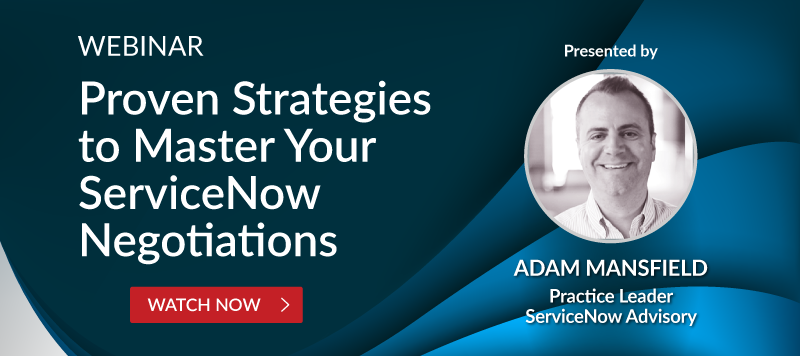- Bearson Smith
- Reading Time: 4 minutes

As we have written before, ServiceNow is evolving quickly and is not the same company that it once was. It is becoming a cloud giant and catching up with enterprise vendors like Salesforce. We see many similarities between these cloud vendors, who stimulate growth through small changes in their licensing and pricing models, which lead to lasting cost impacts for customers. One of the small changes that continues without much coverage is ServiceNow’s willingness and ability to adjust its pricing models or licensing metrics for their products as new family releases roll out, like London, Madrid, New York, etc.
Making changes to the metrics is not a new tactic by enterprise cloud vendors but it seems to be a more frequent occurrence with ServiceNow. Over the last few years, they have had many changes to their various products — the first and biggest transformation was splitting up their core offering, IT Service Automation (ITSA Unlimited). As it broke out into IT Service Management (ITSM), IT Business Management (ITBM), Governance Risk and Compliance (GRC), and Customer Service Management (CSM), the metrics changed with each product. ITSA was previously metered by user type (requester, approver, and fulfiller) based on the functionality a specific user would need. Each user type had a different price based on the rights in functionality, with requesters having the least amount of rights and fulfillers having the most.
ITSM, ITBM, and CSM User Roles
While the licensing model and user types tied to ITSM stayed the same, ITBM changed the user types to worker, planner, and analyst, all of which have different price points, functionality and rights associated with them. CSM also adopted a new user license model that only has one tier, labeled “CSM” users. Both of these models only touch users that need the subscription functionality, so enterprise customers only pay for the functionality their users are actually using.
GRC and HR Service Delivery Users Beware: Pricing Affects Entire Enterprise
Unlike ITSM, ITBM and CSM, where the products are subscribed to based on the number of users that use the functionality, GRC changed in a manner that now requires subscriptions and fees tied to every employee in the enterprise. While ServiceNow made GRC available at a lower overall cost, the significant increase in volume that comes with this licensing change greatly raises the overall cost associated with a subscription product offering.
The next change that can have a significant impact on go-forward costs incurred by enterprise customers is the change from HR Service Automation to what it is now called HR Service Delivery. Like GRC, this pricing model changed from fulfiller users (those that have direct contact with full rights and access to the product) to HR users, which translates to an even wider breadth of users, touching every full- or part-time employee, contractor, or contingent worker that is serviced by ServiceNow’s HR application. While again at a lower base cost than before, the volume becomes exponentially larger as it sets upfront expenses with go-forward rising costs that are inevitable.
ITOM Split Means New Pricing Model
Finally, the most recent change happened as part of the recent New York family release which split IT Operations Management (ITOM) into ITOM Health, ITOM Visibility, and ITOM Optimization. Each individual application divides the features already included in ITOM, while also switching the pricing model to be more specific about which devices touch the applications.
Previously, ITOM was metered per node, defined as any physical or virtual server. The metrics are now more specific as to which types of servers can touch each instance in the form of configuration items (CI). The CI categories are Containers, PaaS, Servers, and Unresolved Monitored Objects and are observed within each instance. Additionally, resources that ITOM applications discover, monitor, and provision are CIs stored in the configuration management database (CMDB). The ITOM licensing module combines the information on CIs with information on customer subscriptions to produce statistics on use by individual applications.
With the new pricing model, each application can be bought separately or as a bundle which creates a more customized plan for an organization to pick and choose the functionality that fits its needs. With this customization, it is important for customers to monitor use by the overall enterprise to ensure there is not overspend (e.g., paying for air for any unutilized subscriptions).
New Mixed Pricing Translates to More Complex Negotiations
With all of these changes and those that will inevitably come down the road, it is most important to note that any negotiated terms on pricing or discounting that an enterprise customer may have achieved in the past, will be affected. Generally, these terms will have language specifically stating that the products being renewed must have the same pricing model for the protections to be upheld. Enterprise customers need to be aware of these changes well before the renewal date to ensure that there is plenty of time to adjust the internal product roadmap and go-forward cost profiling based on new pricing and associated metrics.
For many reasons, including these changes that have most likely occurred since your last renewal, it is critically important for all customers to begin renewal discussions with ServiceNow as early as possible. We also recommend that you have them explain the transactional changes which may have major cost implications when it comes time to renew existing products. ServiceNow should be challenged to demonstrate how any change that was made will benefit the customer, and if it does not, why the customer should simply accept it and its implications. This would also be a good point in the discussion to mention the concerns this raises (taking a tactical and transactional approach to the relationship) and whether it makes sense to further adopt ServiceNow products and expand the relationship.
Comment below, follow me on Twitter @Bearson_ue and follow UpperEdge on Twitter and LinkedIn.
Related Posts
Related Blogs
ServiceNow Impact: The Hidden Costs No One Is Talking About and How to Negotiate Them Down
How Your Cloud Commitment Can Impact Your Next ServiceNow Negotiation
Breaking Down the Mystery Behind ServiceNow Now Assist: Understanding Consumption-Based Licensing
About the Author

